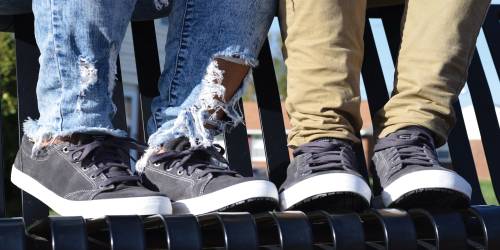09/21/2023
Buyers Guide: What Makes an Amazing Slip-Resistant Shoe?

 In 2019 the National Institute for Occupational Safety and Health released a study that showed a 67% reduction in slip injury claims among 17,000 school cafeteria employees. The reason for such a huge drop? Slip-resistant shoes. The takeaway? Slip-resistant footwear is vital for employee safety, especially if they’re working in potentially hazardous conditions.
In 2019 the National Institute for Occupational Safety and Health released a study that showed a 67% reduction in slip injury claims among 17,000 school cafeteria employees. The reason for such a huge drop? Slip-resistant shoes. The takeaway? Slip-resistant footwear is vital for employee safety, especially if they’re working in potentially hazardous conditions.
But what are you supposed to do when there are literally tons of slip-resistant shoe options on the market today? While it’s good to have options, there’s a point where too many can become overwhelming. But with the right information, your employees can simplify their search and get exactly what they need in no time.
For those team members looking to score the perfect pair of slip-resistant shoes for their job, shoes that not only look good but feel comfy and help keep them protected, here are the top three points to keep in mind.
Athletic vs. Slip-Resistant Work Shoes
Some of our favorite brands produce some awesome athletic shoes with the right amount of grip for sports like basketball, tennis or running. But these shoes are a no-go for slippery work environments.
When it comes to sports, some grip is good, but too much can wreak havoc on your knees when twisting and turning. So, when you’re scouring the internet for new slip-resistant footwear to keep your employees feeling safer on the job, standard athletic shoes won’t cut it. They’re simply not designed for the workplace, and ignoring that reality could end up costing you big time (we’re talking about potential serious injury here and a boatload of medical expenses).
No matter your industry—whether it’s medical, food service, hospitality, manufacturing, or anything in between—if your employees work in a slippery environment, they absolutely MUST wear the right protective footwear. One way to be sure your employees are getting the protection they need is to look for a little number called the Coefficient of Friction (COF). The COF measures the amount of friction existing between two surfaces with a range of 0-1. The higher the COF, the better the slip resistance. For slippery work environments, you’ll want at least a COF of .40. That’s not a number you will find on your everyday athletic shoes.
The good news is that many of your favorite athletic brands, like Reebok and SKECHERS, have partnered with us to make shoes with our special MaxTRAX® slip-resistant outsoles (with a COF of .40 or better) for even the most dangerous work environments.
The Problem with the term “Slip Resistant”
 Let this sink in for a moment: “Slip Resistant” is NOT a regulated term. That means there’s no amount of grip legally required to call shoes “slip resistant.”
Let this sink in for a moment: “Slip Resistant” is NOT a regulated term. That means there’s no amount of grip legally required to call shoes “slip resistant.”
While there are universally recognized standards for safety toe shoes, this just hasn’t been the case for slip-resistant footwear. That’s why companies often throw this term around willy-nilly and get away with it. For many of them, it’s little more than marketing buzz.
The key takeaway is that your employees could be wearing a pair of so-called “slip-resistant” shoes right now that would feel more like ice skates on a slippery kitchen floor. That’s big news for people working in industries with a higher risk of slips and falls.
On the bright side, the American Society for Testing and Materials (ASTM) has recently provided a testing method (ASTM F2913) and a performance spec (ASTM F3445) to improve slip-resistant labeling. We’re glad to see some movement toward better consumer protections, but it’s still not enough.
Since the ASTM F3445 performance spec only requires testing on dry and wet surfaces, it just doesn’t do much for those of us working on oily or oily/wet surfaces. However, that doesn’t mean that slip-resistant footwear is ineffective in those environments; it just means that the ASTM F3445 label doesn’t account for them.
Here at SR Max®, we want to give our customers peace of mind. So, we ensure ALL our products meet our rigorous standards by testing them on various surface types: dry, wet, oily, and oily/wet.

Remember MaxTRAX® and You Can Forget the Rest
COF and ASTM testing are the two largest factors your employees should keep their eyes on while shopping for slip-resistant shoes. But if they don’t want to fuss with all that, all they have to remember is one word: MaxTRAX®.
In the early days of SR Max®, we explored many of the “slip-resistant” tread options out there, but we just weren’t satisfied. Their poor performance didn’t sit well with us, and we refused to sell anything we didn’t trust and wouldn’t wear ourselves. The goal should always be to select a shoe with a tread pattern that gives you maximum contact with the surface you’re walking on while also channeling away any liquids. The result? You’re more likely to stay on your feet! The problem? Tons of options out there failed this basic litmus test.
So, we rolled up our sleeves and created our own slip-resistant outsole. We call it MaxTRAX.®, and we absolutely love it. It not only kills it in independent testing, but our favorite brands love it too. Okay, time to name drop. We’re talking about Timberland PRO, Reebok Work, SKECHERS Work and Florsheim, to name a few.
The reality is that when you have a powerhouse combo of the right materials and a tread pattern that channels water away from your foot, you get a pretty epic slip-resistant shoe.
There are lots of other factors that impact your employees’ safety in slippery environments, including things like their gait (i.e., the way you walk), weight, flooring, surface conditions, and, of course, whether they’re paying attention. Slip-resistant shoes aren’t a cure-all, but they can drastically improve the odds of staying safe on the job. With our corporate customers, we’ve seen slip-and-fall rates plummet by simply implementing a corporate shoe program. That’s because what you put on your feet matters.
So, when your employees are in the market for a new pair of slip-resistant shoes, keep this handy checklist in mind.
- Look for slip-resistant shoes designed for safety in the workplace, not basic athletic shoes.
- Look for the COF of at least 40.
- Dig deeper than the term “slip resistant” to ensure you’ve got a quality pair of safety shoes.
- When in doubt, just remember MaxTRAX®.
If you’re on the hunt for some amazing shoes that tick all the boxes, just hop on over to SR Max®.
Curious about how our customizable, corporate shoe programs can help reduce employee risk?
Categories: Featured | Authored by: SRMax | Posted: 09/21/2023


